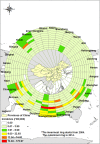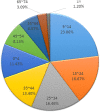Molecular epidemiology of acute hemorrhagic conjunctivitis caused by coxsackie A type 24 variant in China, 2004-2014
- PMID: 28332617
- PMCID: PMC5362916
- DOI: 10.1038/srep45202
Molecular epidemiology of acute hemorrhagic conjunctivitis caused by coxsackie A type 24 variant in China, 2004-2014
Abstract
To understand control interventions, the molecular epidemiology of acute hemorrhagic conjunctivitis (AHC) was investigated from 2004 to 2014.A total of 613,485 AHC cases (annualized cases 55,771) with two deaths were included. Our findings showed that AHC was reported in all provinces, predominantly in Southern and Eastern China. The incidence rates were highest in 2007 (5.65/100,000) and 2010 (21.78/100,000) respectively. A clear seasonal pattern was identified with a peak from August to October. AHC cases occurred in all age groups; however, five to 14 years was the predominant group [23.06%, 133, 510/578,909]. The median age was 24 years (one month~97 years). The median duration from onset to diagnosis was 1.5 days, and there was no difference between the <15, 15~60 and >60-year-old patients [p = 0.0653]. The phylogenetic analysis of 100 nonstructural proteins (3C) and 84 structural proteins (VP1) revealed that AHC outbreaks were caused by Coxsackievirus A24 variant. Genotypes G4-c5a, G4-c5b, and G4-c3 co-circulated with both temporal and geographical overlaps. In conclusion, despite the overall steady decline in the number of AHC cases since the peak in 2010, it still remains a serious public health problem in Southern and Eastern China that targets on the school aged children under 15 years old.
Conflict of interest statement
The authors declare no competing financial interests.
Figures






Similar articles
-
Multiple outbreaks of acute hemorrhagic conjunctivitis due to a variant of coxsackievirus A24: Guangdong, China, 2007.J Med Virol. 2008 Oct;80(10):1762-8. doi: 10.1002/jmv.21288. J Med Virol. 2008. PMID: 18712817
-
An Outbreak of Acute Hemorrhagic Conjunctivitis Caused by Coxsackievirus A24 in Eastern Uttar Pradesh, India 2023.Intervirology. 2024;67(1):106-113. doi: 10.1159/000540952. Epub 2024 Oct 22. Intervirology. 2024. PMID: 39437765 Free PMC article.
-
[Molecular Identification and Phylogenetic Analyses of Coxsackievirus A24v Causing an Outbreak of Acute Hemorrhagic Conjunctivitis in Jiangxi, China, in 2010].Bing Du Xue Bao. 2015 May;31(3):251-7. Bing Du Xue Bao. 2015. PMID: 26470530 Chinese.
-
[Enteroviruses responsible for acute hemorrhagic conjunctivitis].Med Mal Infect. 2010 Apr;40(4):212-8. doi: 10.1016/j.medmal.2009.09.006. Med Mal Infect. 2010. PMID: 19836177 Review. French.
-
Acute hemorrhagic conjunctivitis.Am Fam Physician. 1992 Jan;45(1):173-8. Am Fam Physician. 1992. PMID: 1309404 Review.
Cited by
-
Coxsackievirus A24 causing acute conjunctivitis in a 2023 outbreak in Vietnam.Int J Infect Dis. 2024 Sep;146:107133. doi: 10.1016/j.ijid.2024.107133. Epub 2024 Jun 13. Int J Infect Dis. 2024. PMID: 38876162 Free PMC article.
-
Wastewater monitoring allows the detection of uncommon and highly pathogenic enterovirus types.Appl Environ Microbiol. 2025 Jul 23;91(7):e0053425. doi: 10.1128/aem.00534-25. Epub 2025 Jun 23. Appl Environ Microbiol. 2025. PMID: 40548730 Free PMC article.
-
Pentavalent Sialic Acid Conjugates Block Coxsackievirus A24 Variant and Human Adenovirus Type 37-Viruses That Cause Highly Contagious Eye Infections.ACS Chem Biol. 2020 Oct 16;15(10):2683-2691. doi: 10.1021/acschembio.0c00446. Epub 2020 Sep 16. ACS Chem Biol. 2020. PMID: 32845119 Free PMC article.
-
Molecular Characterization of Coxsackievirus A24v from Feces and Conjunctiva Reveals Epidemiological Links.Microorganisms. 2021 Mar 5;9(3):531. doi: 10.3390/microorganisms9030531. Microorganisms. 2021. PMID: 33807540 Free PMC article.
-
Epidemiology and Sequence-Based Evolutionary Analysis of Circulating Non-Polio Enteroviruses.Microorganisms. 2020 Nov 25;8(12):1856. doi: 10.3390/microorganisms8121856. Microorganisms. 2020. PMID: 33255654 Free PMC article. Review.
References
-
- Wright P. W., Strauss G. H. & Langford M. P. Acute hemorrhagic conjunctivitis. Am Fam Physician 45, 173–178 (1992). - PubMed
Publication types
MeSH terms
Substances
LinkOut - more resources
Full Text Sources
Other Literature Sources
Miscellaneous

